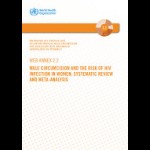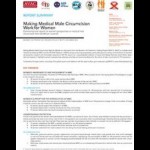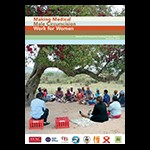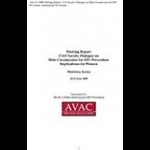Data from randomised clinical trials show male circumcision can reduce men's risk of acquiring HIV from their female partners by about 60 percent. This intervention also has important implications for women. The available data suggest there are important indirect health benefits of male circumcision for women, in particular a reduced risk of exposure to HIV and other sexually transmitted infections (STIs). These indirect benefits would be longer term, emerging over time in communities where male circumcision is widely accepted and rolled out. As male HIV prevalence drops, so does women’s risk.
Women as advocates partners in decision-making
Women’s concerns
Benefit to women
Key issues
Resources
Women as advocates and partners in decision-making
Women have engaged with voluntary medical male circumcision (VMMC) since the earliest days of research on the subject, and have helped inform programming and raised issues, questions, and concerns about this strategy (see Resources). In communities that traditionally circumcise young men as an initiation rite, women have been at the forefront of advocacy for improving the safety and health messages of both traditional and medical surgery.
As guardians, partners, relatives, and friends, women play a key role in creating demand for VMMC and informing the choices of the men in their lives. Examples of women’s roles in supporting VMMC include:
-
In focus group discussions conducted in three countries, adolescent women said they viewed men with circumcised penises as more attractive than uncircumcised men, used their romantic relationships or the potential for sex as leveraging points to convince men to become circumcised, and demonstrated supportive attitudes in the post-circumcision wound-healing period. Interviews with young men confirmed that encouragement from women was a motivating factor in seeking VMMC.1
-
A study conducted by Jhpiego and the Ministry of Health and Social Welfare in 2014 revealed that women in the Njombe and Tabora regions of Tanzania had a significant influence on men’s and boys’ decisions to get circumcised, as described in the AVAC blog, “No circ, no sex.”2
-
A 2012 study in Nyanza Province, Kenya, found that women could indeed influence their partners’ decisions to undergo VMMC and could support post-operative care and adherence to the requisite six-week abstinence period.3
-
The 2010 report, Making Medical Male Circumcision Work for Women, documents women’s understanding of and desire to become involved and back VMMC as an important intervention with benefits of cleanliness and STI and HIV prevention, among others.4
Continued advocacy is needed to ensure that women are engaged in VMMC programming and that they understand the risks, benefits, and requirements of the procedure.
Women’s concerns
Over the past decade, an array of data have emerged addressing some initial concerns about VMMC and its impact on rates of condom use, coercive sex, number of sex partners, and difficulties for women to negotiate safe sex or insist on condom use, particularly with a circumcised man. There were also concerns about gender-based violence, including worries that if a man who has undergone VMMC acquires HIV, he may blame his primary partners. In addition, there were fears about the potential risks for onward transmission if a man living with HIV resumes sexual activity before complete wound healing.
The concern for many women around risk compensation — an increase in risk behaviours due to a false sense of security or protection that can occur with any partially protective HIV prevention strategy — has been a central fear. As access to VMMC has accelerated since 2008, it has become possible to collect data on this topic in the specific context of HIV prevention programming. A number of studies across countries show little evidence of higher risk behaviours as a result of exposure to VMMC programmes.5,6,7,8,9
Even where there is some element of risk compensation,10,11,12 mathematical modeling indicates it would have to be substantial to offset the benefits of decreased HIV prevalence resulting from widely scaled up circumcision. Complete negation of the benefits would occur only if at least 40 percent of the circumcised men in a country significantly increased risky behaviour.13 The impact on women, however, is very sensitive to the occurrence of early resumption of sex.
Benefit to women
Advocates, civil society, and other stakeholders are also interested in understanding and translating, at a community level, the potential indirect benefits to women of male circumcision. Scientific modeling studies suggest that expanded uptake of male circumcision for HIV prevention in specific epidemics will translate to an eventual reduction in HIV incidence and prevalence in women as they are exposed to fewer HIV-infected men.
In 2017, a systematic review of the association between male circumcision and women’s biomedical health outcomes showed evidence of increased benefits to women.14 Out of the 60 publications assessed, the evidence showed that female partners are at decreased risk of several diseases, including cervical cancer, cervical dysplasia, herpes simplex virus type 2, chlamydia, syphilis, and human papillomavirus. The evidence also showed a protective association with HIV; however, this connection was weaker because one trial showed an increased risk to female partners of HIV-positive men resuming sex early after male circumcision.
Before the 2017 review, a downward shift in men’s prevalence and subsequent benefits to women were noted. In Orange Farm, the South African township where the first randomised controlled trial to test VMMC was conducted, follow-up assessments in 2010–2011 show an associated community–level benefit. The male HIV prevalence was lowered by 20 percent in just three years during the time that VMMC was scaled up to 58 percent among 15 to 29 year olds.15 Significantly, a study conducted in the same community revealed in 2014 that VMMC rollout was associated with a 17 percent to 20 percent reduction in HIV incidence among women whose only sex partners were medically circumcised men.16 This is the first time VMMC has been shown to have an indirect protective effect on women.
Additional potential indirect benefits for women come from strategies that use male circumcision programmes for HIV prevention to reach young men and their partners with information and services on HIV and STI risk reduction, HIV testing and treatment, gender equity, contraception, and shared sexual decision-making.
A 2015 study in HIV-positive men found that penile HIV shedding spiked up to three weeks after circumcision, and then dropped significantly compared to pre-circumcision levels. This is evidence that abstinence before wound healing is essential for women’s protection. Lower viral load is also associated with less viral shedding.17
It is important to understand how women's sexual practices may be influenced by VMMC as an HIV prevention effort. Women's beliefs about VMMC and sexual behaviour will likely influence its scale-up and uptake. Qualitative interviews with women in Kisumu, Kenya, showed a good understanding of the partial protection of VMMC for acquisition of HIV for men. Women perceived circumcised men as cleaner, carrying fewer diseases, and taking more time to reach ejaculation.18
Key issues
Due to the high incidence of HIV infection among women, particularly young women, it is important to continue to assess potential risks and benefits of expansion of male circumcision programmes on women.
Some specific critical issues related to women include:
-
Messages about male circumcision and its risks and benefits; its place in the spectrum of proven prevention options; and its impact on women's ability to negotiate safer sex with stable and casual partners.
-
Impact of male circumcision on women's risk of acquiring HIV from circumcised, HIV-positive partners (who may or may not know their status and may or may not wait for full wound healing before resuming sexual activity).
-
Impact on men's behaviour, such as changes in rates of high-risk sex, coercive sex, and condom use.
-
Research on men's and women's sexual satisfaction and pleasure following male circumcision.
-
Impact of new male circumcision programmes on national- and community-level priority-setting around HIV prevention and on staff at health facilities who may be asked to add male circumcision to existing services.
-
Impact on women's involvement in pre-existing customs and/or cultural rituals involving male circumcision for neonates and/or for adolescent boys as a rite of passage.
References
-
Kaufman MR, Dam KH, Sharma K, et al. Females' peer influence and support for adolescent males receiving voluntary medical male circumcision services. Clin Infect Dis 2018;66(suppl 3):S183-188.
-
Osaki H, Mshana G, Wambura M, et al. “If you are not circumcised, I cannot say yes”: The role of women in promoting the uptake of voluntary medical male circumcision in Tanzania. PLoS One 2015;10(9): e0139009. doi:10.1371/journal.pone.0139009.
-
Lanham M, L’Engle KL, Loolpapit M, et al. Women’s roles in voluntary medical male circumcision in Nyanza Province, Kenya. PLoS ONE 2012;7(9):e44825. doi:10.1371/journal.pone.0044825.
-
Women's HIV Prevention Tracking Project (WHIPT). Making Medical Male Circumcision Work for Women, accessed August 10, 2015
-
Kong X, Kigozi G, Nalugoda F, et al. Assessment of changes in risk behaviors during three years of posttrial follow-up of male circumcision trial participants uncircumcised at trial closure in Rakai, Uganda. Am J Epidemiol 2012;176(10):875-885. doi:10.1093/qje/kws179.
-
Westercamp N, Agot K, Jaoko W, et al. Risk compensation following male circumcision: results from a two-year prospective cohort study of recently circumcised and uncircumcised men in Nyanza Province, Kenya. AIDS Behav 2014;18(9): 1764-1775. doi:10.1007/s10461-014-0846-4.
-
Auvert B, Taljaard D, Rech D, et al. Association of the ANRS-12126 male circumcision project with HIV levels among men in a South African township: evaluation of effectiveness using cross-sectional surveys. PLOS Med 2013;10(9): e1001509. doi:10.1371/journal.pmed.1001509..
-
Gray RH, Kigozi G, Kong X, et al. The effectiveness of male circumcision for HIV prevention and effects on risk behaviors in a post-trial follow up study in Rakai, Uganda. AIDS 2012;26(5):609–615. doi:10.1097/QAD.0b013e3283504a3f.
-
Agot KE, Kiarie JN, Nguyen HQ, et al. Male circumcision in Siaya and Bondo Districts, Kenya: prospective cohort study to assess behavioral disinhibtion following circumcision. J Acquir Immune Defic Syndr 2007;44(1):66–70.
-
Hewett PC, Hallet TB, Mensch BS, et al. (Abstract only). Sex with stitches: assessing the resumption of sexual activity during the postcircumcision wound-healing period. AIDS 2012;26(6):749-756. doi:10.1097/QAD.0b013e32835097ff.
-
Abbott SA, Haberland NA, Mulenga DM, et al. Female sex workers, male circumcision and HIV: a qualitative study of their understanding, experience, and HIV risk in Zambia. PLoS ONE 2013;8(1):e53809. doi:10.1371/journal.pone.0053809.
-
Kibira S, Nansubuga E, Tumwesigye N. Male Circumcision, Sexual Behavior and HIV Status in Uganda. Demographic and Health Surveys Working Paper No.100. Calverton, Maryland, USA: ICF International, 2013.
-
Londish GJ, Murray JM. Significant reduction in HIV prevalence according to male circumcision intervention in sub-Saharan Africa. Int J Epidemiol 2008;37(6):1246-1253. doi:10.1093/ije/dyn038.
-
Grund JM, Bryant JS, Jackson I, et al. Association between male circumcision and women’s biomedical health outcomes: a systematic review. Lancet Glob Health 2017;5(11):E1113-1122.
-
Auvert B, Taljaard D, Rech D. Association of the ANRS-12126 male circumcision project with HIV levels among men in a South African township: evaluation of effectiveness using cross-sectional surveys. PLoS Med 2013;.doi:10.1371/journal.pmed.1001509.
-
Jean K, Lissouba P, Taljaard D, et al. HIV incidence among women is associated with their partners' circumcision status in the township of Orange Farm (South Africa) where the male circumcision roll-out is ongoing (ANRS-12126). 20th International AIDS Conference. Melbourne, Australia, 20-25 July 2014. Abstract FRAE0105LB.
-
Tobian AR, Kigozi G, Manucci J, et al. HIV shedding from male circumcision wounds in HIV infected-men: a prospective cohort study. PLOS Med 2015;12(4):e1001820. doi:10.1371/journal.pmed.1001820.
-
Westercamp M. The Circumcision Impact Study in Kisumu, Kenya 2008–2013. Kisumu, Kenya: Nyanza Reproductive Health Society, 2013
Additional References
Nakasi S. Uganda must move fast on HIV. New Vision, 29 September 2011.
Khanyisa D. Circumcision can reduce HIV risk. News 24, 4 April 2014.










